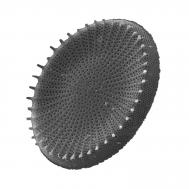Algea
In the Research Area Algae, we study algae, with a focus on diatoms (Bacillariophyceae ).
Despite their small size, diatoms are of outstanding ecological importance. The oxygen released by their photosynthetic activity accounts for around 20 % of global oxygen production, although diatoms only make up around 1 % of global biomass. The number of known species is around 18,000. However, based on conservative estimates of the number of as yet unknown species, this figure is likely to be at least 200,000. Due to their worldwide distribution in waters of all kinds, diatoms are used both as bioindicators of water quality and as proxies for reconstructing the history of the earth's climate.
Only with the aid of the microscope, especially the high-resolution electron microscope, can the characteristic morphological subtleties of their glass-like shells be revealed to the observer. In addition to these morphological observations of collection objects from herbaria, we are increasingly using DNA sequence data to reconstruct evolutionary relationships. Short sequence fragments are also used for identification (barcoding and metabarcoding).
Our work focuses on taxonomy and phylogenetic reconstruction as well as on the assessment of species diversity in different types of water bodies using morphological and molecular approaches. Molecular studies show that there are characteristic biogeographical distribution patterns. Central concerns are the analysis of the position of species in the ecosystem and their position in the natural system of organisms as a result of evolutionary diversification.


